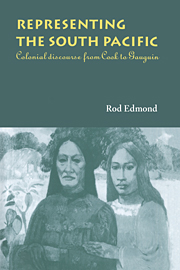Book contents
- Frontmatter
- Contents
- List of illustrations
- Acknowledgements
- 1 Introduction
- 2 Killing the god: the afterlife of Cook's death
- 3 Mutineers and beachcombers
- 4 Missionary endeavours
- 5 Trade and adventure
- 6 Taking up with kanakas: Robert Louis Stevenson and the Pacific
- 7 Skin and bones: Jack London's diseased Pacific
- 8 The French Pacific
- 9 Epilogue
- Notes
- Index
5 - Trade and adventure
Published online by Cambridge University Press: 31 October 2009
- Frontmatter
- Contents
- List of illustrations
- Acknowledgements
- 1 Introduction
- 2 Killing the god: the afterlife of Cook's death
- 3 Mutineers and beachcombers
- 4 Missionary endeavours
- 5 Trade and adventure
- 6 Taking up with kanakas: Robert Louis Stevenson and the Pacific
- 7 Skin and bones: Jack London's diseased Pacific
- 8 The French Pacific
- 9 Epilogue
- Notes
- Index
Summary
‘She had adventure after adventure, of course, the Pacific is that sort of place.’
(Bill Manhire, ‘Cannibals’)By mid-century the excitement generated by the European discovery of the islands of the South Pacific was dwindling. Both the region and much of the writing about it had become missionarydominated, and those ideal versions of the Polynesian constructed by Enlightenment and Romantic discourse were becoming redundant. An important factor here was the shift in attitudes to race and empire in Britain as the ethnocentric humanitarianism of the early nineteenth century gave way to the scientific racialism of the mid- and late century. Events elsewhere reinforced this racialism while deflecting attention from the Pacific. The breakdown of the Jamaican economy following the end of slavery resulted in the negro becoming the mid-century type of the ineducable savage, and after Governor Eyre's brutal imposition of martial law at Morant Bay in Jamaica in 1865, and the controversy over this in England, the stereotyping became more vicious. The American Civil War also concentrated attention on the black population of North America. These events, and the Indian Mutiny of 1857, were strongly racialized and had their effect on mid-century representations of Pacific islanders.
Economically and politically the Pacific islands offered few inducements for annexation. The region was marginal to the economic needs of Europe and North America and had little strategic importance until the end of the century.
- Type
- Chapter
- Information
- Representing the South PacificColonial Discourse from Cook to Gauguin, pp. 130 - 159Publisher: Cambridge University PressPrint publication year: 1997

